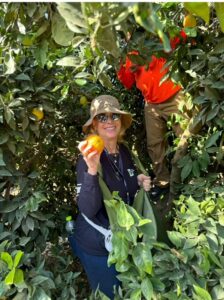By Donald H. Harrison


SAN DIEGO – Approximately 30,000 evacuees from San Diego’s sister city of Sha’ar Hanegev and the neighboring municipality of Eshkol, both within a close distance of Israel’s border with Gaza, are returning to their homes, where they will find that volunteers from Jewish National Fund-USA have rebuilt, refurbished, and repainted some of the structures that were damaged or destroyed during the Oct. 7 Hamas-led massacre. New facilities are also being planned.
Russell F. Robinson, chief executive officer of JNF-USA, which has been intimately involved in the resettlement of Israel’s internal refugees, told San Diego Jewish World that many of the evacuees have been living with 4 to 5 people in a single hotel room, with no kitchen facilities, and having had only 24 hours to bring with them bare necessities before being evacuated from their endangered homes.
The parents cannot work at their regular jobs because Israeli businesses near Gaza also had to be shuttered and evacuated. The children have been going to temporary school and after-school programs. There is “psychological damage for the evacuees, not only from what happened on October 7th but just the horrific staying away from home,” Robinson said.
The evacuees’ return to Sha’ar Hanegev and Eshkol should be accomplished by the end of March or the first weeks of April, Robinson said. Sha’ar Hanegev is a collection of ten kibbutzim, one moshav, and Ibim, an educational village where new immigrants learn Hebrew and Israeli living skills. Sapir College is adjacent to Sha’ar Hanegev and the separate city of Sderot. Eshkol Municipality bordered by Gaza to the west, and Egypt to the south, has 14 kibbutzim, 15 moshavim, and three non-collective villages.


In the five months since October 7th, JNF-USA has brought to Israel over 200 American volunteers per week in its “Build Together” program. The volunteers pay their own way to pick crops that otherwise would rot, pack meals for the IDF, and work on projects within individual communities such as those in Sha’ar Hanegev that had been evacuated. Sol Lizerbram, the national president of JNF-USA and his wife Lauren, who are San Diego County residents, have been among the volunteers.
“Lauren worked and Sol managed,” Robinson quipped.
About 200,000 people from the many communities in southern Israel near the Gaza border and in northern Israel near the Lebanese border were evacuated shortly after the October 7 attack.
Robinson said that since then, in Sha’ar Hanegev, volunteers have been “redoing their community center and their schools.” The missile-proof high school that was built years ago in Sha’ar Hanegev with the help of JNF-USA and the Jewish Federation of San Diego, for which Sha’ar Hanegev is a partnership region, has been converted into an Army base and “it is going to be that for at least another year,” Robinson said. “But you have to have education for the kids so we found all these old schools at the kibbutzim and we renovated them with our volunteers together with Israelis.”
Additionally, JNF has renovated the community center with a reopening event planned to be a big “reveal moment” that “is not going to take away the circle of pain, but it is going to get ‘em dressed and out the door during this tremendously painful time of their lives,” Robinson said.
Other projects are a sports complex for soccer and lacrosse, and maybe baseball; new housing areas throughout the Sha’ar Hanegev municipality, local civil defense centers, and a resilience center to help those in need of psychological counseling.
One resilience center is already under construction in the Eshkol municipality and “we’re going to start building one in Sha’ar Hanegev as well,” Robinson said. “Mental therapy is complex. You are going to need children therapy, adult therapy, senior therapy. By having it in one big center you are able to have the staffing and meet the needs.” While the Sha’ar Hanegev facility is being planned and constructed, Sha’ar Hanegev residents will travel to Eshkol for treatment, he added.
Prior to the war, Sha’ar Hanegev, Eshkol and Sderot were among the many places in southern Israel that were the targets of rockets fired by Hamas and allied terrorist groups in Gaza. While most of the rockets landed harmlessly in fields or were shot down by Israel’s Iron Dome defense system, some found their way to do damage and inflict casualties. Residents hope that the current war will end the threat, but new installations still are being hardened against rocket attacks.
The sports center had already been planned before Oct. 7 and “we are going to construction in the next couple of weeks,” Robinson said during the March 15 interview. Outdoor sports facilities must have close-by safe areas in case of rocket attacks. “What you do is you build things under the seats, a well-protected area. You have to be very creative in how you build. The locker rooms are not just locker rooms, they are protected bomb shelters and the bathrooms are protected bomb shelters. You make it look like a beautiful environment but the reality is that it also has all the security and safety that you need for the people.”
Construction of the sport center “will take a year and maybe a couple of months in case of construction delays,” Robinson said. “We’re going to have a celebration of lacrosse and soccer playing in the ‘Israel envelope’ and it will be a time in which, yes, we will have all the issues that this war has caused: the destruction, the death, the trauma, the PTSD, but we are going to have a celebration that this is a place to move to. We used to say it (the region) is 95 percent heaven and 5 percent hell. We are hoping that it is going to be 100 percent heaven.”
And maybe build a baseball field? “We are building a baseball field in Beit Shemesh, and we have one in Tel Aviv, and we have one up north, so I am all for it,” Robinson responded. “We also sponsor baseball in Israel, so maybe, who knows, maybe we will build a baseball field there.”
The Israel communities along the Gaza border had been referred to as the “Gaza envelope” before Oct. 7th but Robinson said residents have said “we don’t want to be called that anymore,” and so the term ‘Israel envelope’ had been substituted.
“Police departments in Israel are national, not local like we have in the United States, so we are helping the residents set up their own local civil defense centers with volunteer fire departments, ambulances” and communications with the IDF and the national police, Robinson said. “Every small moshav and kibbutz will have civil defense, so it gives them a feeling of security. God, forbid it happens again, but even if it never happens again, we’re ready.”
Robinson said volunteer trips to Israel coordinated by JNF-USA are filled up through October, but “if people want to get their hands literally in the soil of Israel, we have trips going almost every week.” JNF-USA also is running a campaign promoting the purchase of Israeli merchandise as gifts for beleaguered Israelis. “Come to JNF.org if you want to help small businesses stay in businesses,” he said. “We’re delivering boxes and packages to soldiers and to people in hospitals. You don’t have to know them. We are delivering thousands of boxes to the north and the south every week, if you want to stand with the people of Israel.”
JNF-USA has had a longstanding goal of helping Israel persuade citizens who crowd the central core cities of Tel Aviv, Haifa, and Jerusalem and environs, to move to the sparsely-populated regions of the Galilee in the north and the Negev Desert in the south.
The goal has been “to bring 500,000 people to the Negev and the Israel envelope (including Sha’ar Hanegev) is an important component of that,” Robinson said. “Eighty-two percent of Israel’s population lives within a triangle. It is not smart security-wise. If you take October 7th, why did they attack where they attacked? Because for our enemy, keeping 82 percent in the triangle between Tel Aviv, Jerusalem, and Haifa, they know is not sustainable. They were hoping to turn the heaven into hell so people would say, ‘I am never moving back.’
“This is our land. These kibbutzim were established in 1943 in the land of Israel.”
Does Robinson believe there ever will be peace between Israel and Gaza? Answering, Robinson cited the case of the late Mayor Ofir Libstein of Sha’ar Hanegev, who was killed defending Kfar Aza, one of the kibbutzim in Sha’ar Hanegev.
“I texted Ofir at 6:32 a.m. He sent a hand emoji praying, and an hour later he was dead and so was his son,” Robinson said. “If you knew Ofir Libstein, he was consumed with trying to help the Palestinians with economic development. He was planning an economic zone. He was willing to give up land of Sha’ar Hanegev to help create jobs. That is what they killed. Thy killed those kinds of people. They didn’t kill people who hated them. They killed people who were like family before, who cared. Ofir’s wife would help anybody, take them to hospitals. This was about hate, hate for the Jews, hate for Israelis.”
“So, what are the prospects? It comes down to how we raise our children. You and I will raise them to defend themselves, but also to know bad from good. We are going to raise our children to love and respect. The prospect of peace is not about land, it is not about occupation. If everybody doesn’t teach their children about good and bad, and respect, then the prospects for tomorrow, for peace, become very difficult…
“I am hoping that they will learn values and teach their children,” Robinson continued. “You know it wasn’t just Hamas who came across that border. … When Hamas terrorists came over [to Kfar Aza] it was one wave. The second wave was women and children, grandparents, and people even on crutches who came and looted and also set things on fire. So, there are a lot of people who have to look in the mirror and must decide that good must prevail over evil.”
*
Donald H. Harrison is publisher and editor of San Diego Jewish World. He may be contacted via donald.harrison@sdjewishworld.com
Pingback: Oct. 7th Survivor Lauds JNF-USA's Red Mountain Therapeutic Riding Center - San Diego Jewish World
Thank you so very much for the details and insight! Liz Grey DVM